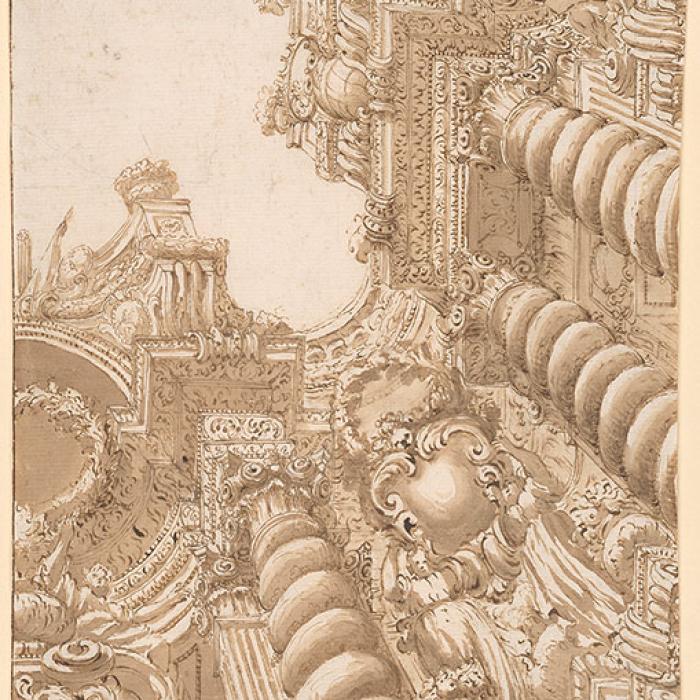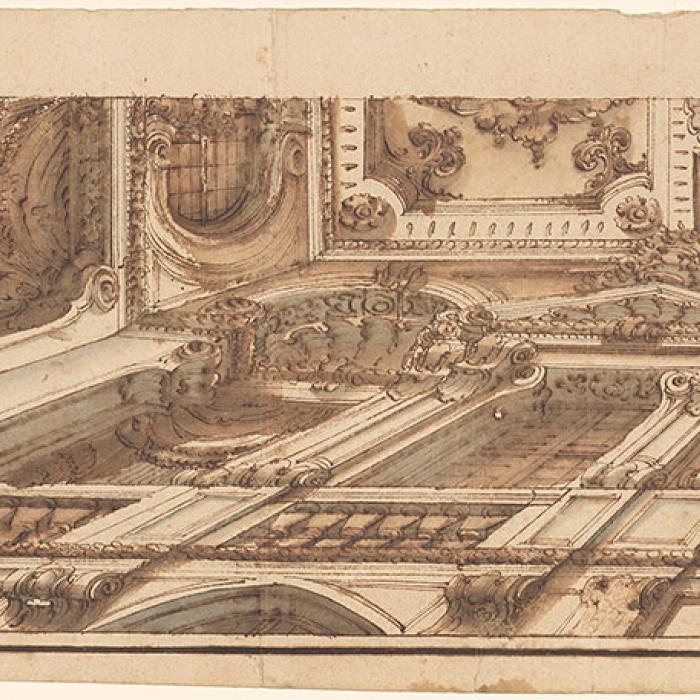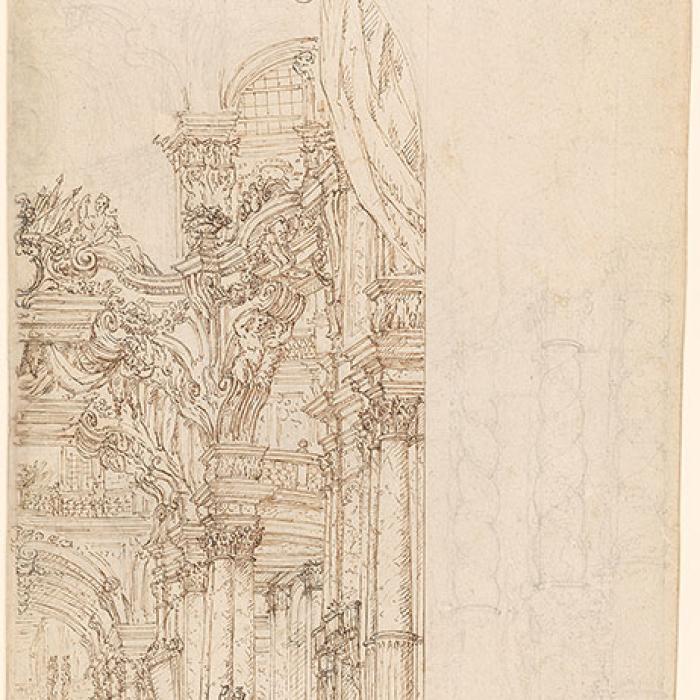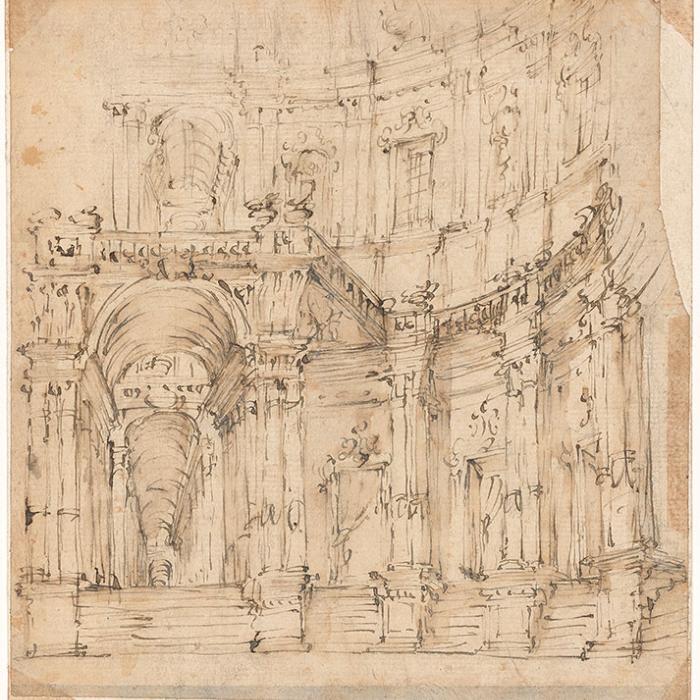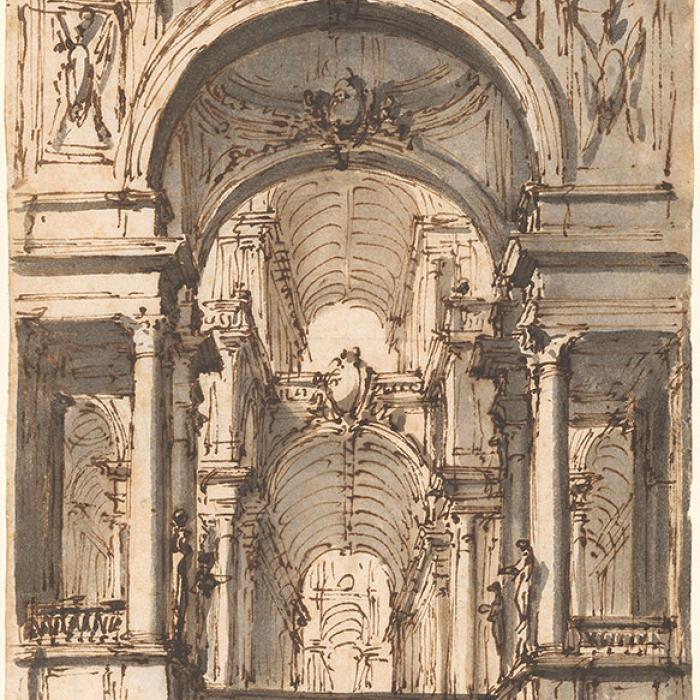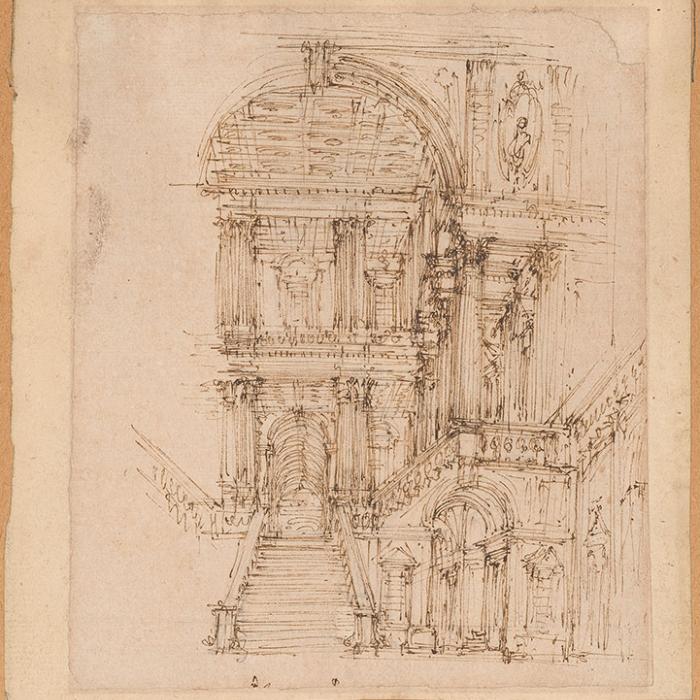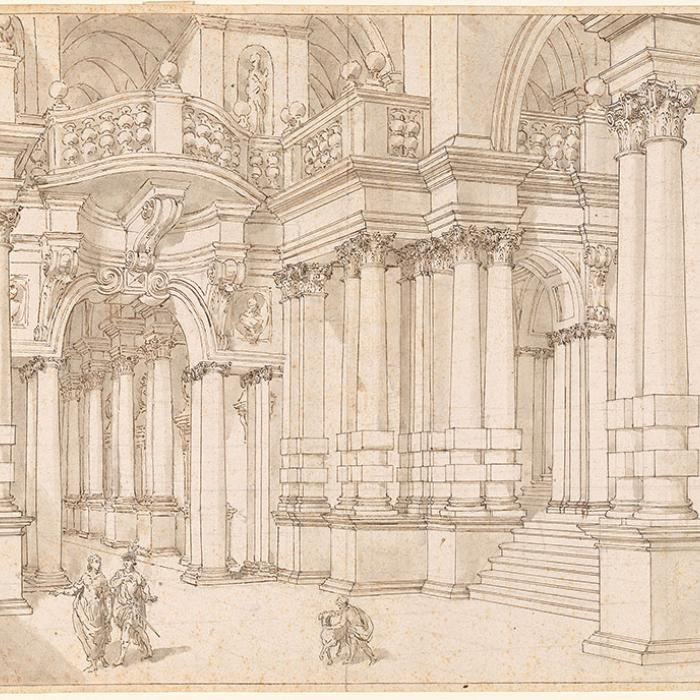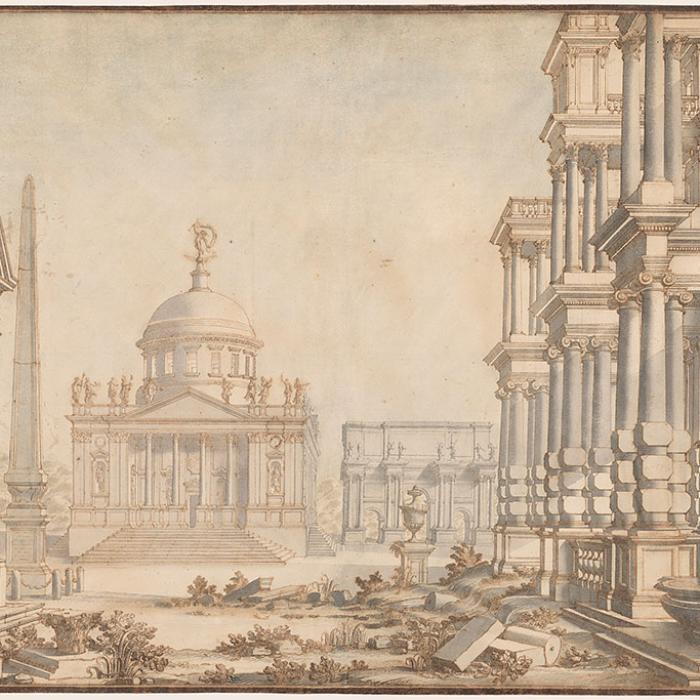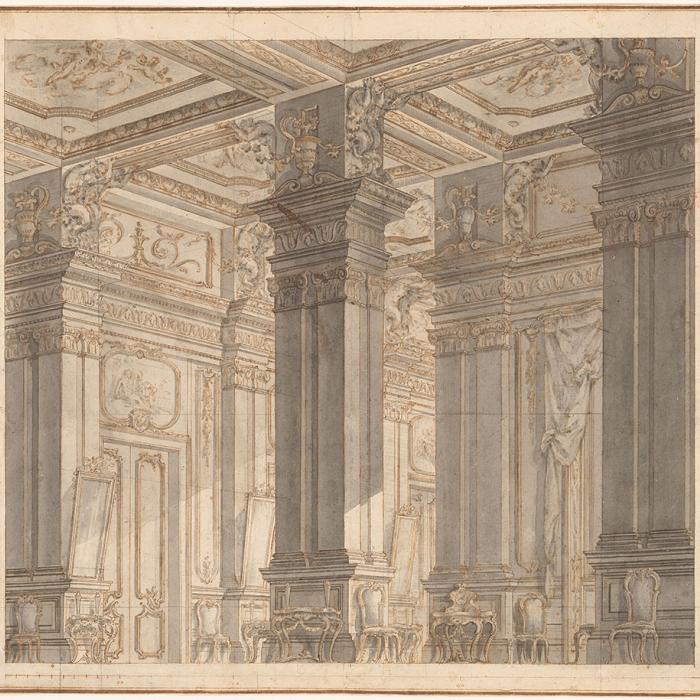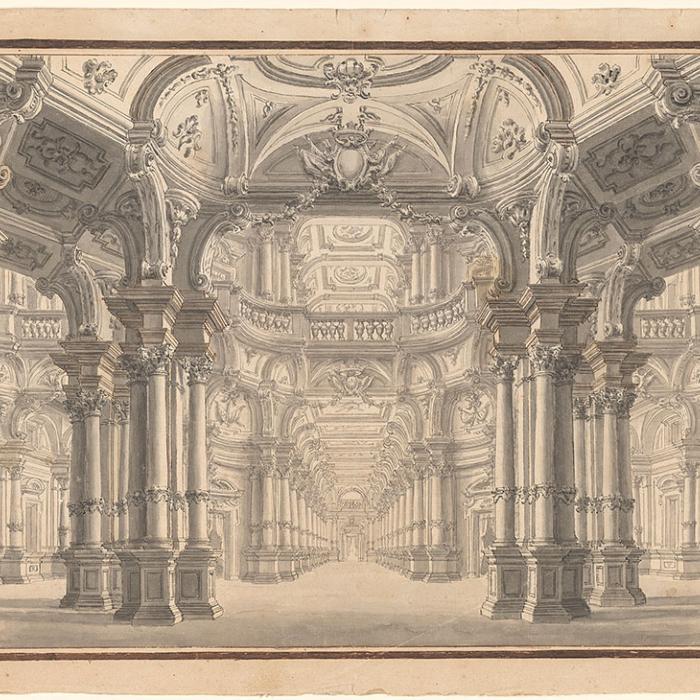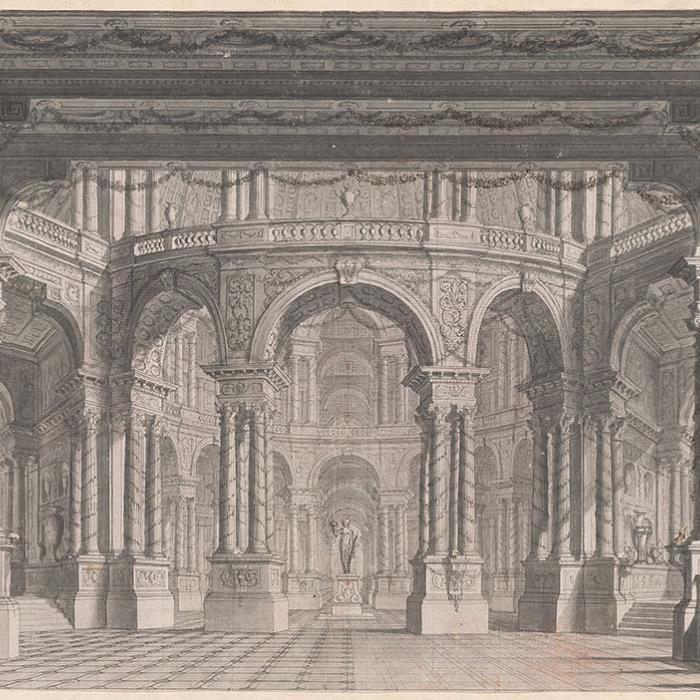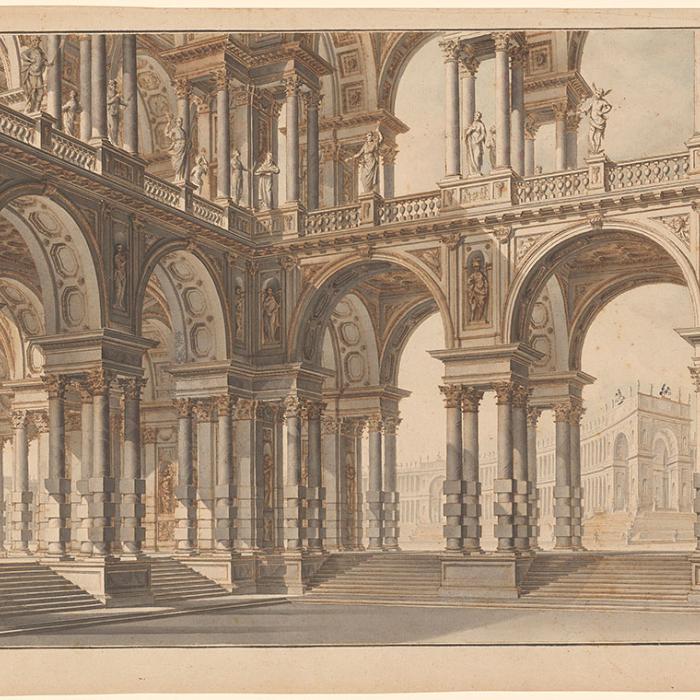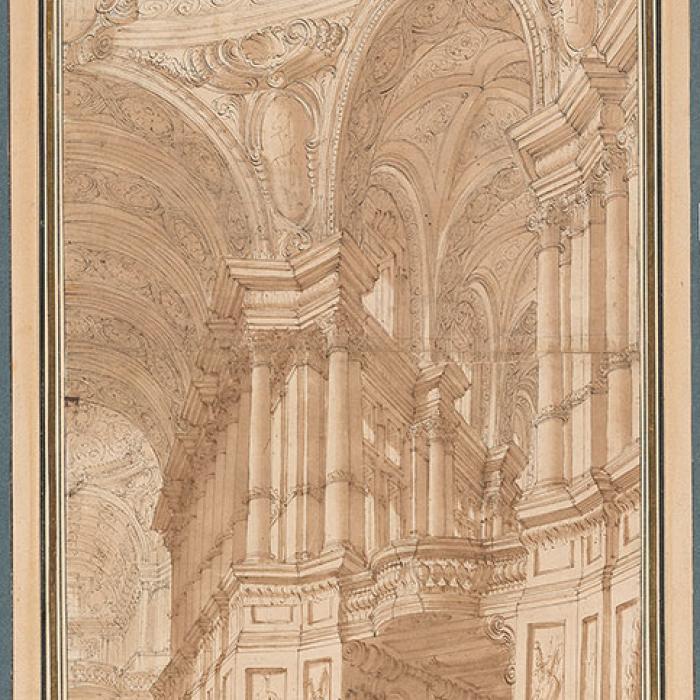Architecture, Theater, and Fantasy: Bibiena Drawings from the Jules Fisher Collection
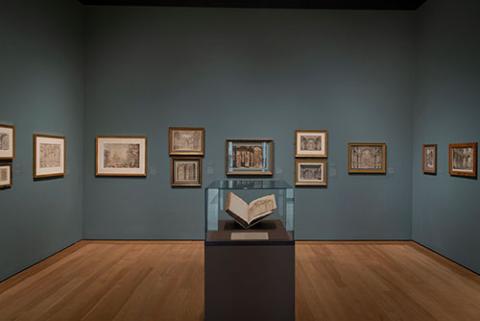
For nearly a century, beginning in the 1680s, members of three generations of the Bibiena family were the most sought-after theater designers in Europe. Their revolutionary stage designs were used for operas, festivals, and courtly performances across the Continent: from their native Italy to cities as far afield as Vienna, Prague, Stockholm, St. Petersburg, and Lisbon. The family built more than a dozen theaters—most famously the Margravial Opera House in Bayreuth, Germany— and issued a series of influential publications on perspective drawing and stage design.
Today, the Bibienas’ distinctive style survives above all through their remarkable drawings. These range from quick sketches to elaborate presentation drawings and complex studies of perspective. Many demonstrate the family’s signature invention: the scena per angolo, or “scene viewed at an angle.” Replacing the static symmetry of earlier theater designs, the scena per angolo used multiple vanishing points at the sides of the stage rather than a single one at the center of the backdrop. The resulting sets were of unprecedented monumentality, with an intensity of movement and a complexity of space never previously imagined.
Architecture, Theater, and Fantasy marks the promised gift to the Morgan of twenty-five Bibiena drawings from the collection of Jules Fisher. During a career spanning more than sixty years, Jules has been the lighting designer for over three hundred Broadway and off-Broadway shows and has received an unmatched nine Tony Awards for lighting design. His drawings will find a home alongside more than one hundred Bibiena drawings, and thousands of theater designs, already in the Morgan’s collection.
This online exhibition was created in conjunction with the exhibition Architecture, Theater, and Fantasy: Bibiena Drawings from the Jules Fisher Collection on view May 28 through September 12, 2021.
Architecture, Theater, and Fantasy: Bibiena Drawings from the Jules Fisher Collection is a program of the Morgan Drawing Institute.
The exhibition is accompanied by a catalogue, available in the Morgan Shop.
Overview
Gallery Images
Project for the Decoration of a Ceiling
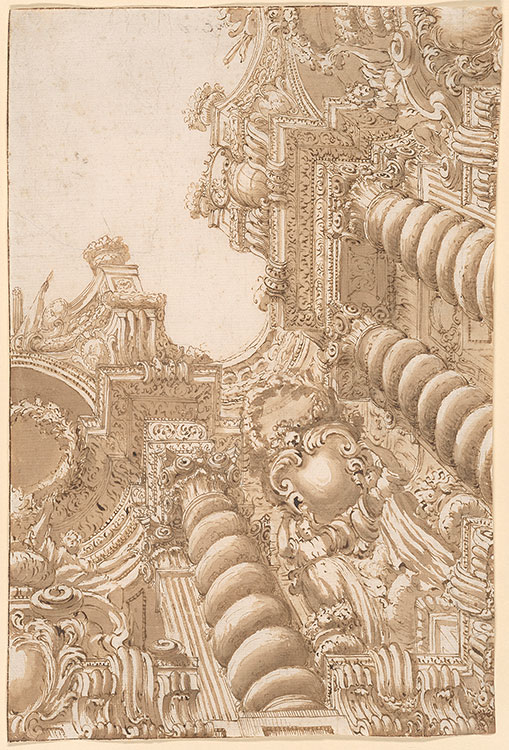
Before they became famous as impresarios of theatrical productions, the Bibienas worked as painters in Bologna and Parma. One of their specialties was quadratura, the decoration of walls and ceilings with illusionistic architectural frescoes. A group of related perspective studies by Ferdinando Bibiena was published in 1701 as the Varie opere di prospettiva (Varied works of perspective). Widely emulated, the engravings in that volume gave birth to drawings like these examples.
Bibiena workshop
Project for the Decoration of a Ceiling, ca. 1710
Pen and brown ink and wash, over graphite
Promised gift of Jules Fisher
Perspective Study

Follower of Ferdinando Galli Bibiena (1657–1743)
Perspective Study, ca. 1705–10
Pen and brown ink, and brown and gray wash
Promised gift of Jules Fisher
Study of an Architectural Perspective
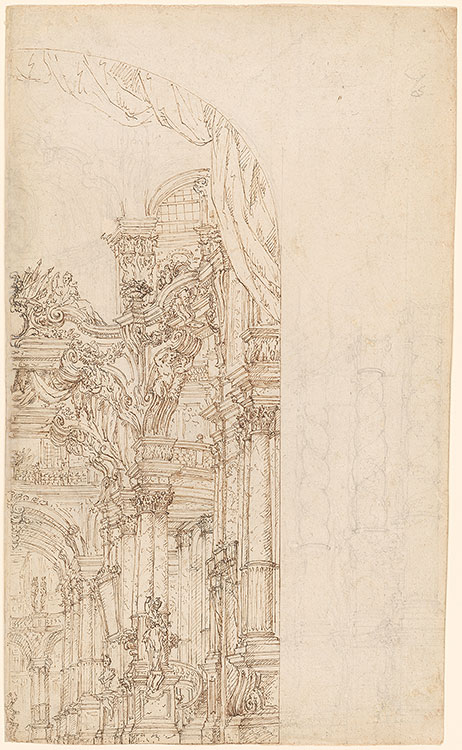
This unfinished drawing of a complex colonnaded space animated by mirrors and statues depicts the right half of a palatial atrium. Baroque stages were rarely decorated with tall vertical backdrops, so if used for a production, the design would have been mirrored, with the left half drawn to match the right.
Follower of Giuseppe Galli Bibiena (1695–1757)
Study of an Architectural Perspective, ca. 1730
Pen and brown ink, over black chalk
Promised gift of Jules Fisher
Design for a Stage Set or a Wall Decoration
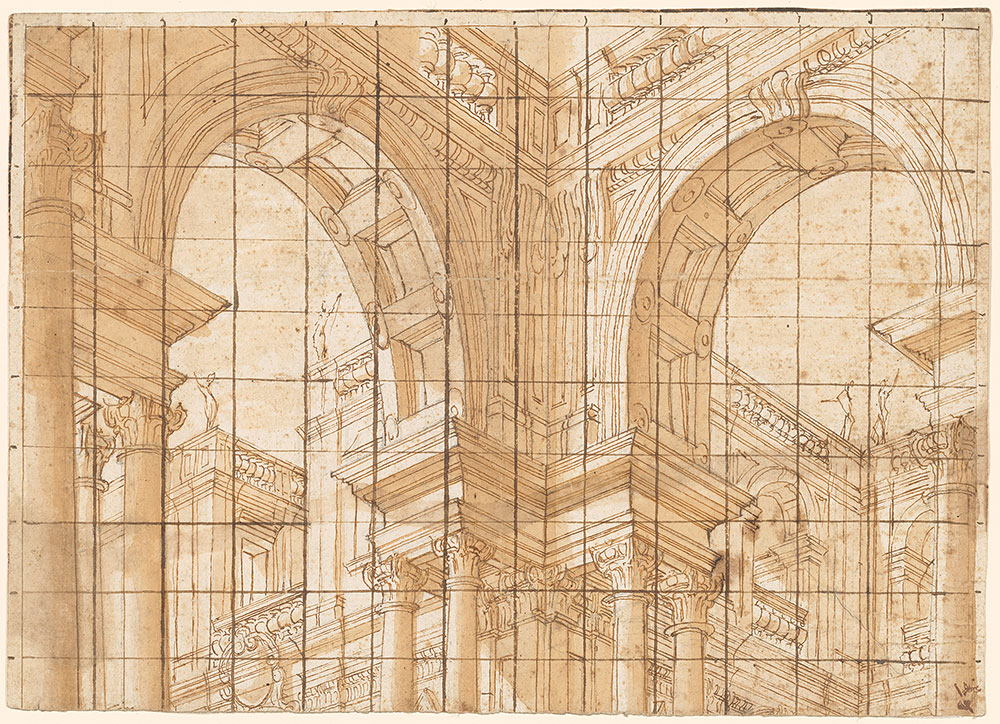
It is unclear whether this drawing was intended as a design for the stage or for a trompe l’oeil wall decoration, though the superimposed grid surely indicates that the scheme was meant to be transferred and enlarged. The sheet is fragmentary, having lost its lower half, but it still conveys the grandeur and complexity of the scena per angolo architectural designs by the Bibiena workshop
Follower of Giuseppe Galli Bibiena (1695–1757)
Design for a Stage Set or a Wall Decoration, ca. 1725–50
Pen and brown ink and wash, over black chalk, squared in pen and brown ink
Promised gift of Jules Fisher
Design for an Architectural Setting

Attributed to Giuseppe Galli Bibiena (1695–1757)
Design for an Architectural Setting, ca. 1720–30
Pen and brown ink and wash, over graphite
Promised gift of Jules Fisher
Stage Designs
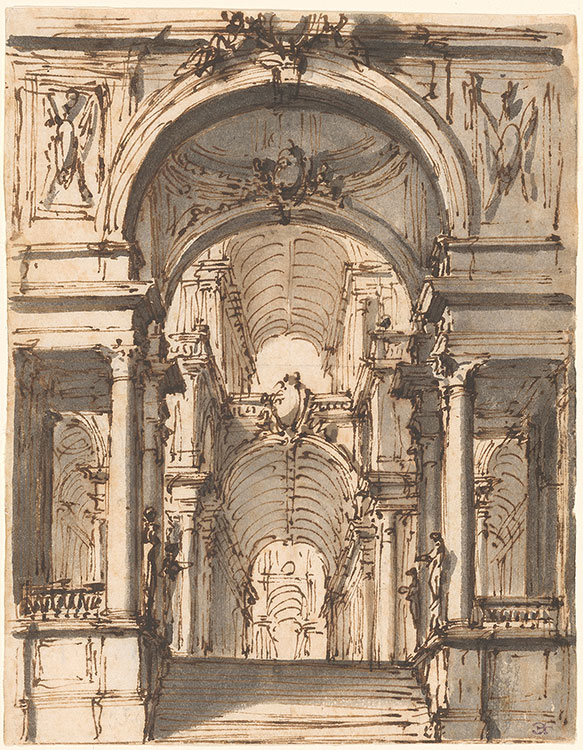
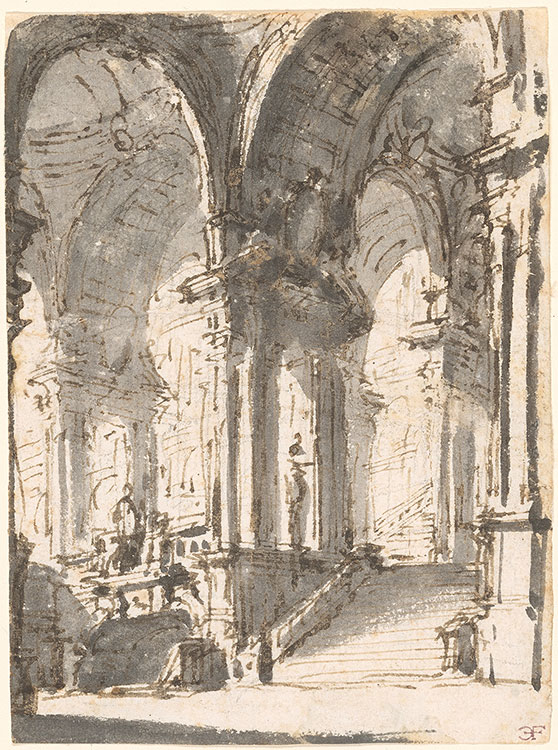
Writing late in life, Ferdinando Bibiena lamented that the architectural worlds he imagined often lost some of their magic as they proceeded from initial sketches—like those seen here—to finished sets: “No doubt the major difficulty that arises in the creation of theatrical scenes and other large scenes in perspective is that of the difference between the original ideal and the final execution. When a sketch or rough drawing is made, the first concept is greatly reduced. One then designs on paper according to the rules of perspective and architecture, but these constraints much diminish the idea. And when the scene is constructed, even more of the spirit that was in the original concept is lost.”
Bibiena workshop
Stage Design: Palace Interior with a Barrel Vault, ca. 1700
Stage Design: Palace Interior with Stairs to the Right, ca. 1700
Pen and brown ink and gray wash
Gift of Jules Fisher; inv. nos. 2021.40–41
Left Portion of a Palatial Hall, a Design for the Stage
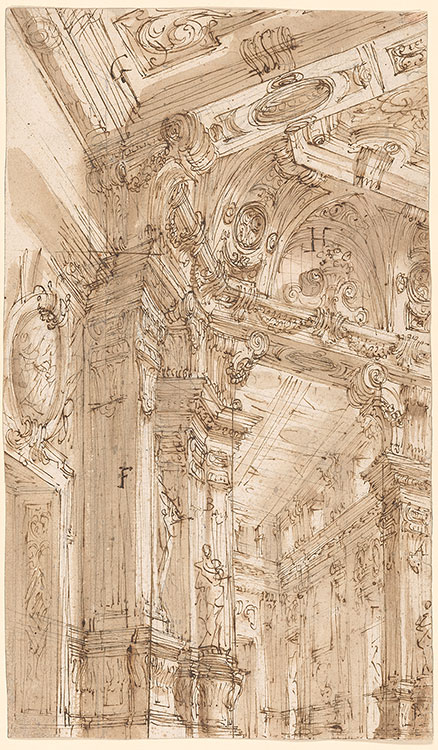
This remarkable working drawing illustrates various stages of the creative process. A graphite underdrawing provided the precise perspective before the artist fluidly rendered the architectural surface ornament of festoons and scrolls in pen and ink. The design also includes notations that suggest how it would be realized in the three-dimensional space of the theater: letters corresponding to different scenery flats that would have come together to create the appearance of a unified stage set. The flats labeled G and H were probably lowered from the rafters, whereas B and F would have been wheeled in from the wings of the stage.
Ferdinando Galli Bibiena (1657–1743)
Left Portion of a Palatial Hall, a Design for the Stage, ca. 1720–30
Pen and brown ink and wash, over graphite
Gift of Jules Fisher; inv. no. 2021.39
Partial View of a Circular Palace Hall with Radiating Rooms, a Design for the Stage
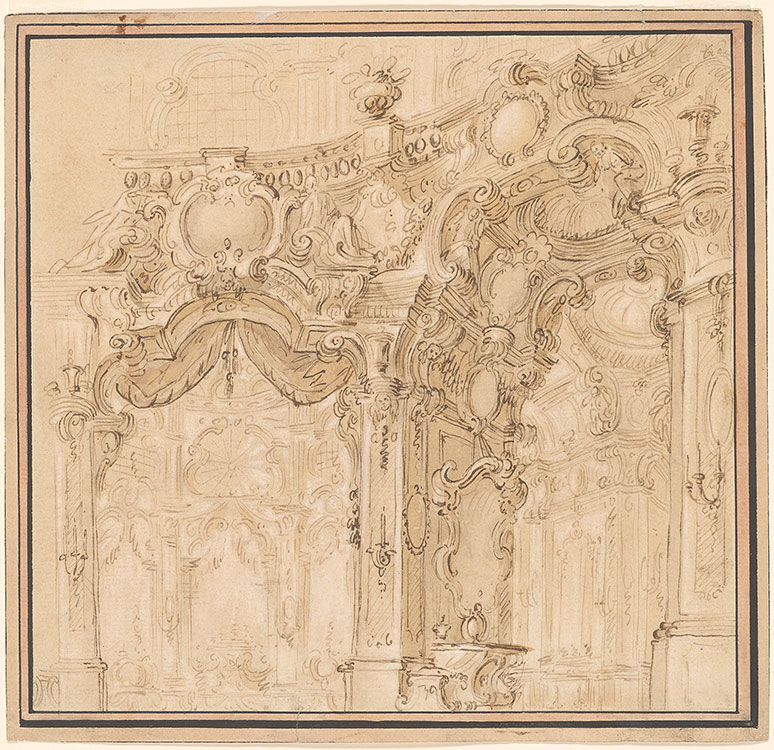
This exuberantly ornate space was drawn in Antonio Bibiena’s typically animated, calligraphic style. Like the adjacent sheets, the drawing represents an early stage in the creative process: sketched first in graphite, it was then worked up in pen, ink, and wash. The brilliantly abstracted figures beneath the arches and along the balustrade are characteristic of Antonio’s lively designs.
Antonio Galli Bibiena (1697–1774)
Partial View of a Circular Palace Hall with Radiating Rooms, a Design for the Stage, ca. 1730
Pen and brown ink and wash, over graphite
Promised gift of Jules Fisher
Three-Story Atrium with Caryatids
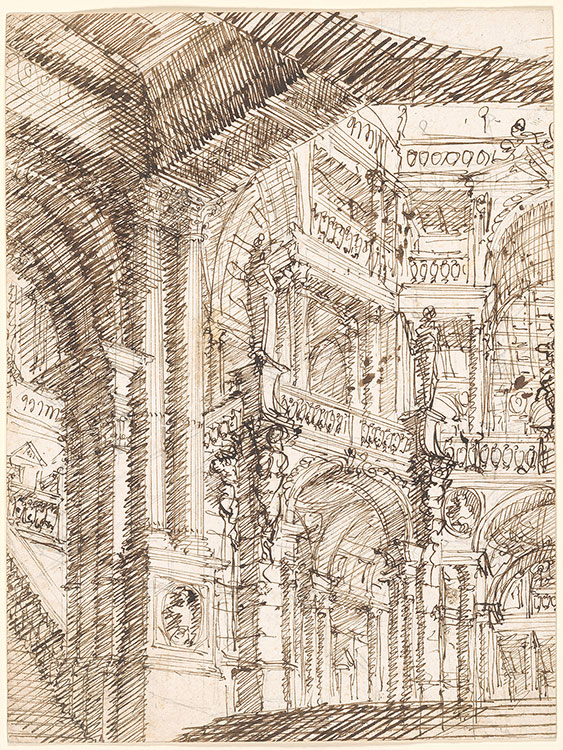
Attributed to Giuseppe Galli Bibiena (1695–1757)
Three-Story Atrium with Caryatids, ca. 1730–50
Pen and brown ink, over leadpoint
Promised gift of Jules Fisher
Staircase of a Palace

Attributed to Alessandro Galli Bibiena (1686–1748)
Staircase of a Palace, ca. 1730–40
Pen and brown ink, over graphite
Collection of Jules Fisher
Entrance to a Palace with Colonnade and Figures
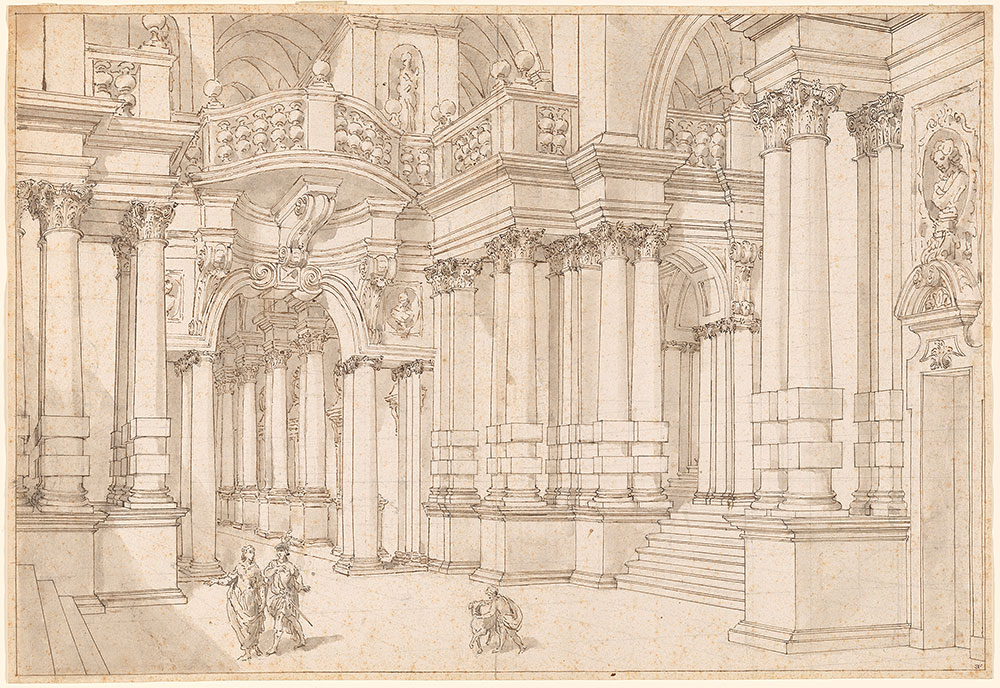
Although more finished than the sketches shown nearby, this sheet retains traces of an underdrawing that reveals the careful attention paid to an accurate projection of the perspective. Bibiena sets would not have included painted figures, so this drawing might record a live production (perhaps as a preparatory study for a commemorative engraving). Alternately, it could be an independent drawing exercise.
Follower of Giuseppe Galli Bibiena (1695–1757)
Entrance to a Palace with Colonnade and Figures, ca. 1750
Pen and brown ink and gray wash, over graphite(?)
Promised gift of Jules Fisher
Capriccio of Rome with Triumphal Arch and Neptune Fountain

Giuseppe Bibiena indulged his penchant for combining reality and fantasy, and ancient and Baroque, in his drawings for Architetture, e prospettive (Architecture, and perspectives). Published in 1740, the volume of engravings was dedicated to Emperor Charles VI and included depictions of court performances, sacred theater, and funerary monuments honoring the members of the imperial family. This capriccio is not a preparatory drawing for any of the engravings, but it compares closely to the fantastic cityscapes seen in a number of them.
Giuseppe Galli Bibiena (1695–1757)
Capriccio of Rome with Triumphal Arch and Neptune Fountain, ca. 1740
Pen and brown ink and gray wash, with blue watercolor, over graphite
Promised gift of Jules Fisher
Colonnaded Stage Set
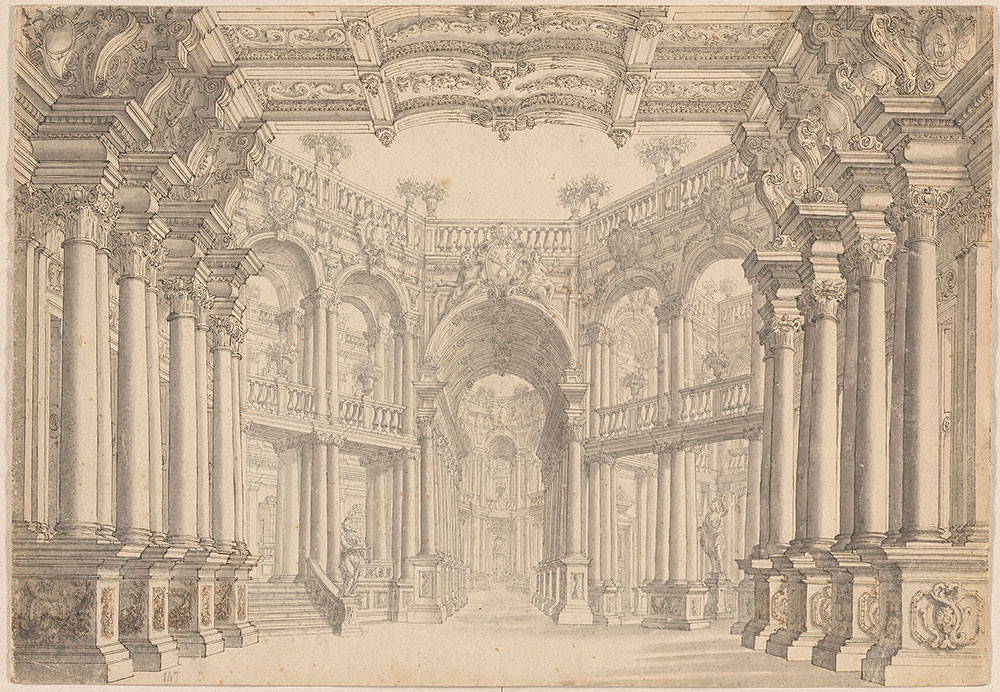
Attributed to Carlo Galli Bibiena (1721–1787)
Colonnaded Stage Set, ca. 1750
Pen and brown and black ink, with gray wash
Promised gift of Jules Fisher
Palace Interior with Tritons and Mirrored Gallery, a Design for the Stage

While the best-known Bibiena sets evoke the courtyards of majestic Baroque palaces, the artists also followed contemporary architectural trends. This design, for example, suggests a grand Parisian hôtel interior, with a unified arrangement of chairs, side tables, and pier mirrors in a room decorated with paintings of gods and goddesses. The sheet may have been executed when Carlo Bibiena was assisting his father in Bayreuth.
Carlo Galli Bibiena (1721–1787)
Palace Interior with Tritons and Mirrored Gallery, a Design for the Stage, ca. 1745–50
Pen and brown ink and gray wash, over black chalk
Gift of Jules Fisher; inv. no. 2021.38
Circular Colonnaded Atrium
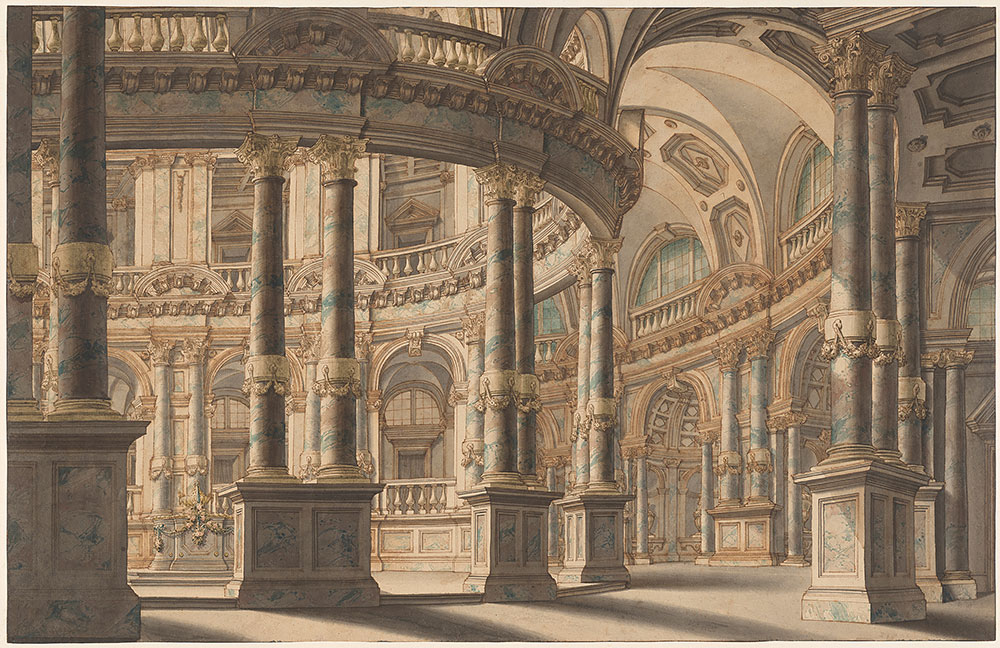
Accurately delineating the perspective of a curving arcade seen at an angle, this impressive sheet is likely an autonomous drawing rather than a design for a theatrical production. Probably by Giuseppe Bibiena, it is akin to drawings executed by his father, Ferdinando, and by Ferdinando’s pupils at the Accademia Clementina in Bologna.
Attributed to Giuseppe Galli Bibiena (1695–1757)
Circular Colonnaded Atrium, ca. 1730
Pen and brown ink, gray wash, blue and green watercolor, and white opaque watercolor
Promised gift of Jules Fisher
Palace Interior with a Domed Area and a Gallery Beyond, a Design for the Stage
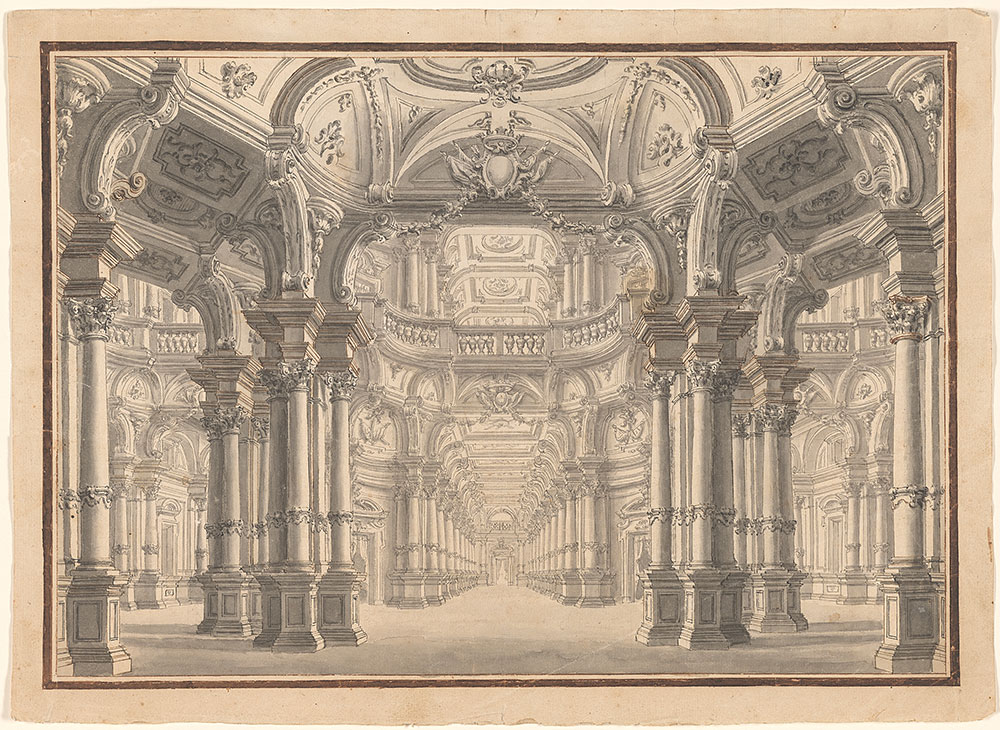
Follower of Giuseppe Galli Bibiena (1695–1757)
Palace Interior with a Domed Area and a Gallery Beyond, a Design for the Stage, ca. 1750
Pen and black and brown ink, and gray wash, over leadpoint
Collection of Jules Fisher
A Colonnaded Stage
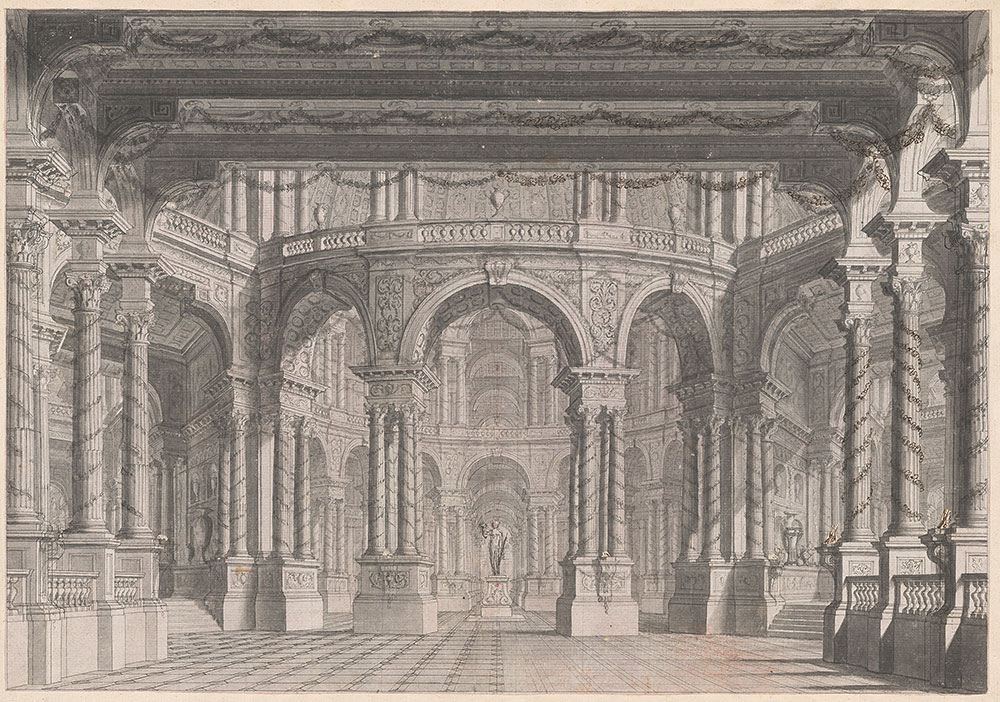
This drawing by Carlo Bibiena dates to early in his career, perhaps to around 1750 when he was assisting his father, Giuseppe, at the Margravial Opera House in Bayreuth. The architectural structure exemplifies Carlo’s formal, restrained draftsmanship; unusually, however, work continued on the sheet even after the highly finished framework was complete. Festoons were added atop the proscenium and columns, and ghostly scrolls were sketched on some of the plinths at left. Fragments of paper attached to the column plinths at right show disembodied hooves or feet, indicating some additional decoration that was glued to the surface but later removed and lost.
Carlo Galli Bibiena (1721–1787)
A Colonnaded Stage, ca. 1750
Pen and brown and black ink, and gray wash
Promised gift of Jules Fisher
Entryway Leading to a Courtyard and Two Levels of Galleries, a Design for the Stage

Although the Bibienas were most famous for their innovative scena per angolo stage designs they also continued to design sets with a central vanishing point, like that used here. An illuminated atrium with densely colonnaded galleries was a motif favored by Giuseppe Bibiena.
Giuseppe Galli Bibiena (1695–1757)
Entryway Leading to a Courtyard and Two Levels of Galleries, a Design for the Stage, ca. 1740–50
Pen and brown ink, gray wash, and blue watercolor, incised
Promised gift of Jules Fisher
Courtyard of a Palace, a Design for the Stage
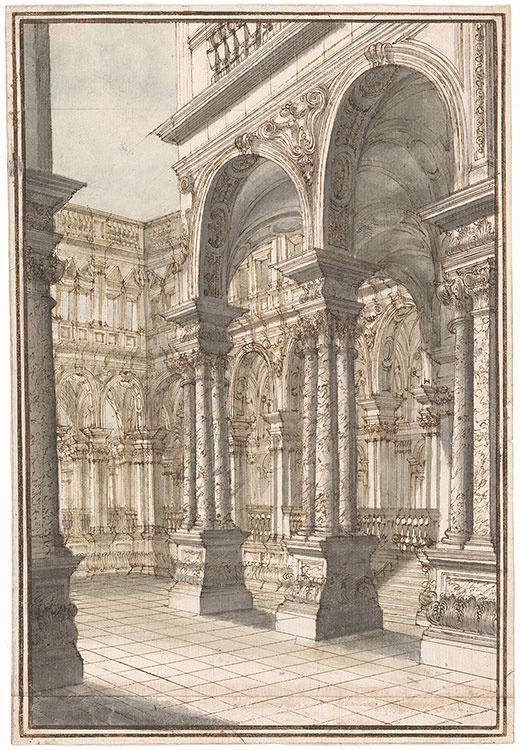
Giuseppe Galli Bibiena (1695–1757)
Courtyard of a Palace, a Design for the Stage, ca. 1710–20
Pen and brown ink, gray wash, and blue watercolor, over graphite
Promised gift of Jules Fisher
Courtyard of a Princely Palace
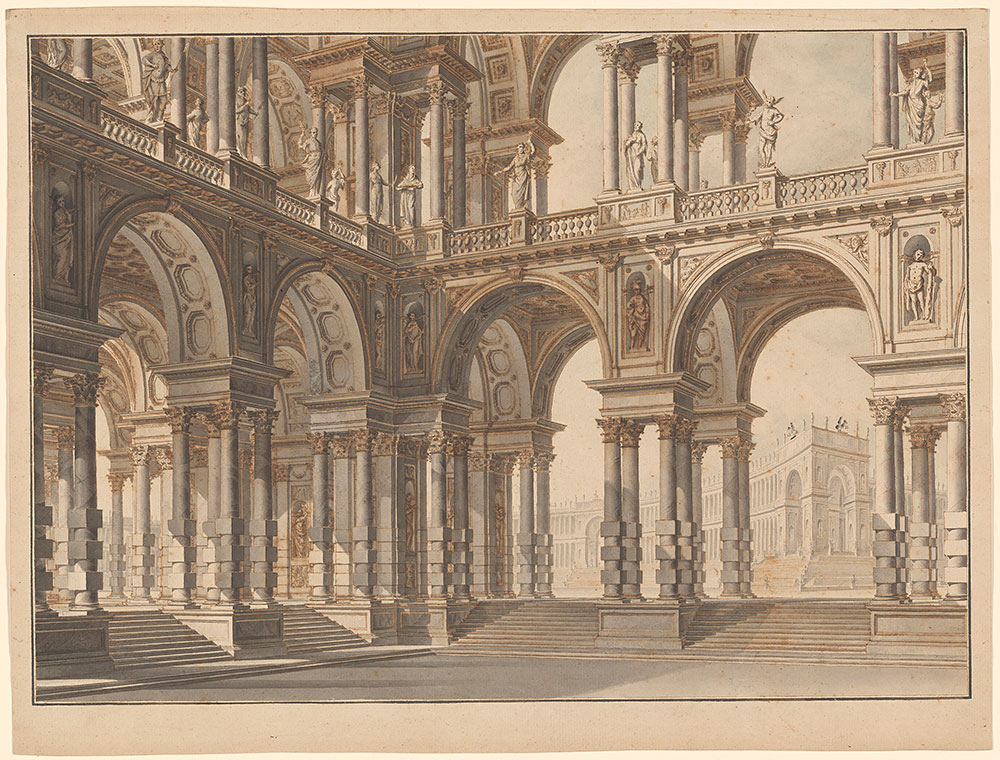
With its double loggia and clusters of beautifully rendered columns, this design bears comparison with engravings in Giuseppe Bibiena’s Architetture, e prospettive. It is especially close to a stage set he designed in 1719 for a production marking the wedding of Prince Frederick Augustus of Saxony and Archduchess Maria Josefa in Vienna.
Giuseppe Galli Bibiena (1695–1757)
Courtyard of a Princely Palace, ca. 1719
Pen and brown ink, gray wash, and blue watercolor
Promised gift of Jules Fisher
Stage Set: Palace Courtyard with Columns and Statues

A courtyard scena per angolo could suggest an expansive palace without depicting the entire structure. As seen here, the repetition of a few groups of columns prompts the viewer to imagine dozens more, just out of view. Even in the relatively small scale of a drawing, the immersive monumentality is palpable. The drawing is unusual in that it shows alternate schemes, one with and one without a proscenium arch framing the view.
Follower of Ferdinando Galli Bibiena (1657–1743)
Stage Set: Palace Courtyard with Columns and Statues, 1720
Pen and brown ink and gray wash, over graphite
Promised gift of Jules Fisher
Stage Set: Grand Palace Hall with Columns and Grand Staircase
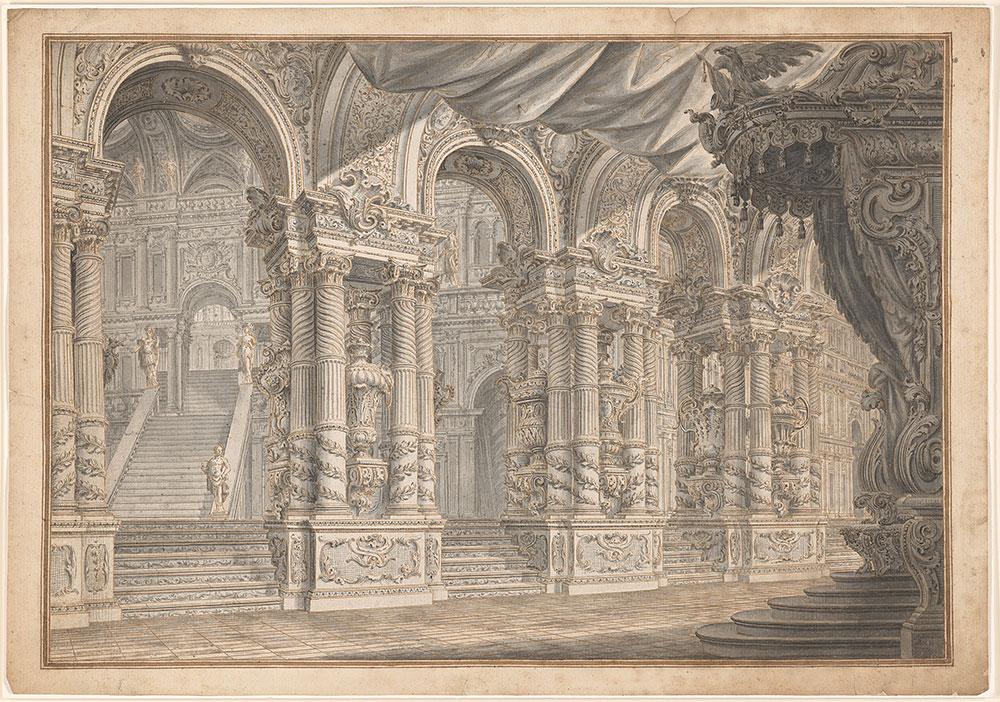
Extraordinary in its range of detail and subtle wash shading, this drawing was probably executed by one of Ferdinando Bibiena’s pupils at the Accademia Clementina in Bologna. A quintessential example of the scena per angolo, the drawing retains prick marks and inscribed lines that show the careful development of its multiviewpoint perspective.
Follower of Ferdinando Galli Bibiena (1657–1743)
Stage Set: Grand Palace Hall with Columns and Grand Staircase, 1719
Pen and brown ink and gray wash, over graphite
Promised gift of Jules Fisher
Palace Interior
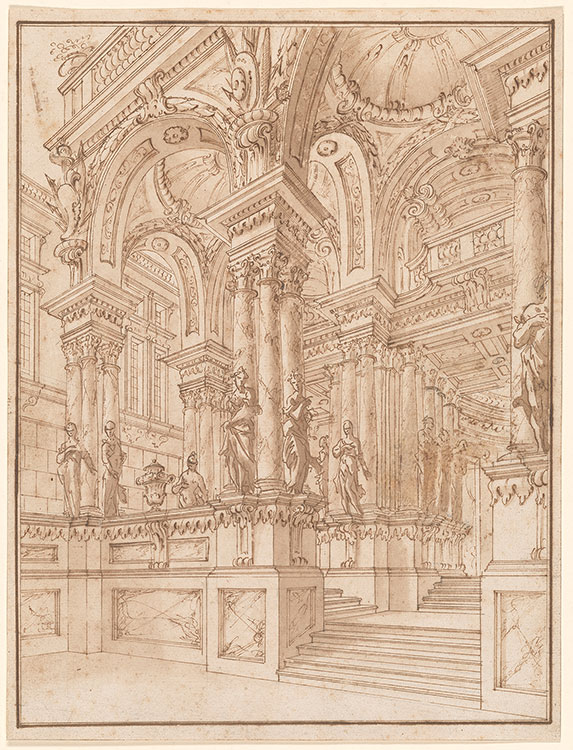
Follower of Ferdinando Galli Bibiena (1657–1743)
Palace Interior, ca. 1710–20
Pen and brown ink and wash, over graphite
Promised gift of Jules Fisher
Half of a Palatial Atrium with One Arch Leading to a Long Hall and the Other to a Low-Ceilinged Corridor and Upper Gallery, a Design for the Stage

Antonio Galli Bibiena (1697–1774)
Half of a Palatial Atrium with One Arch Leading to a Long Hall and the Other to a Low-Ceilinged Corridor and Upper Gallery, a Design for the Stage, ca. 1740–60
Pen and brown and black ink, and brown wash, over black chalk
Collection of Jules Fisher
Stage Design with Sailing Vessels
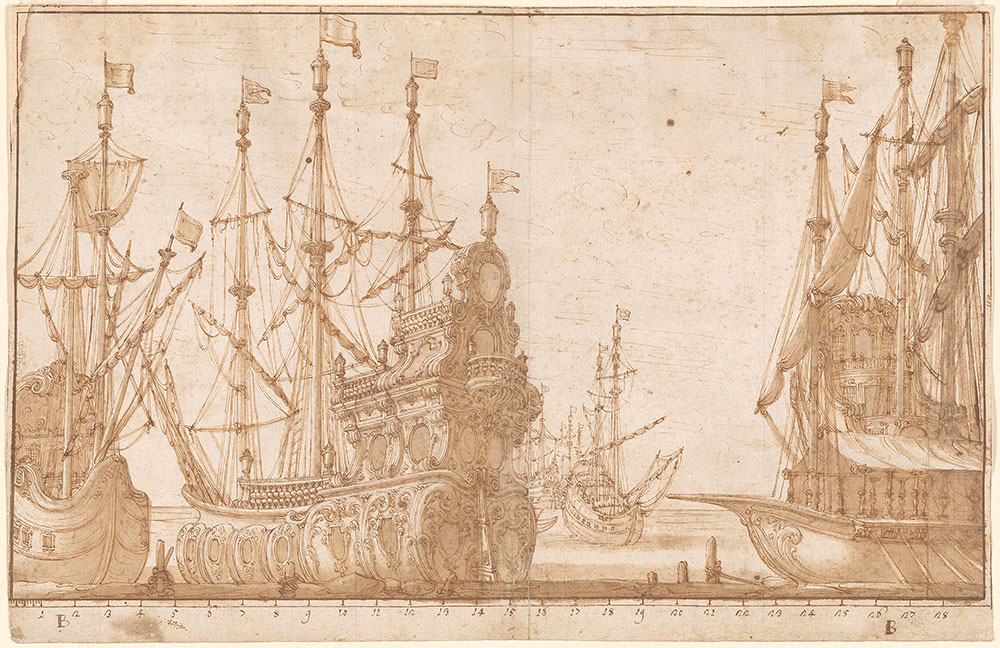
An inscription on the back of this sheet reveals that it was a design for Antonio Vivaldi’s La Cunegonda, an opera performed during carnival in Mantua in 1718, when Francesco Bibiena served as the impresario of the city’s Teatro Comico. As the final setting for the opera, the imposing ships, lit from behind, would have left a strong impression.
Francesco Galli Bibiena (1659–1739)
Stage Design with Sailing Vessels, ca. 1718
Pen and brown ink and wash, over graphite
Gift of Jules Fisher; inv. no. 2021.42
Prison Interior

This sheet is surely a working drawing for a still-unidentified production: its reverse bears a list of scenes that includes the prison setting depicted on the front. Prisons often featured in eighteenth-century theater, but the stairway and gloomy arches of this example are reminiscent of Giovanni Battista Piranesi’s famous Carceri d’invenzione (Imaginary prisons). Piranesi was but one of many artists deeply influenced by the Bibienas, a testament to their impact not merely on the theater but far more broadly on European art of the eighteenth century.
Antonio Galli Bibiena (1697–1774)
Prison Interior, ca. 1725–30
Pen and brown ink and wash, over graphite
Promised gift of Jules Fisher
Album of Drawings by the Bibiena Family and Others
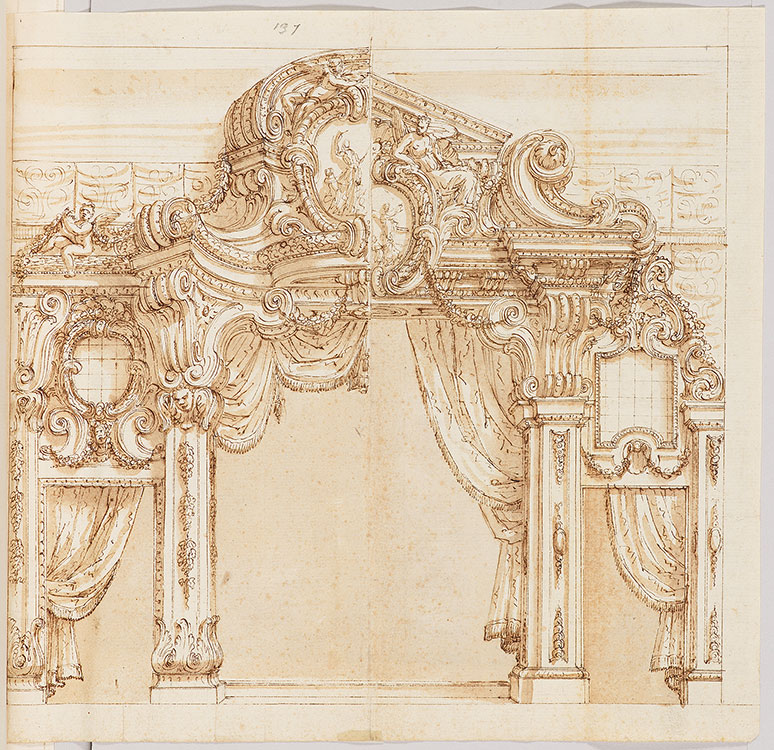
This album of 113 drawings was probably assembled at the end of the eighteenth century. An important sourcebook for Bibiena scholars, it includes many sheets by the Bibienas and their circle—such as Studies for a Proscenium Arch by Ferdinando Bibiena, to which the album is opened. The album also contains a group of drawings by Neapolitan artists of the later seventeenth century. The variety of designs from different schools and workshops might indicate that the volume incorporates material from several earlier compilations. Acquired by Jules Fisher from Wildenstein & Company in 1972, the album has been on deposit at the Morgan since 1987.
Album of Drawings by the Bibiena Family and Others
Collection of Jules Fisher
